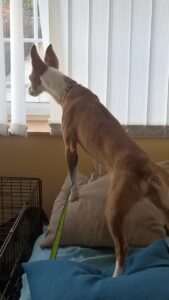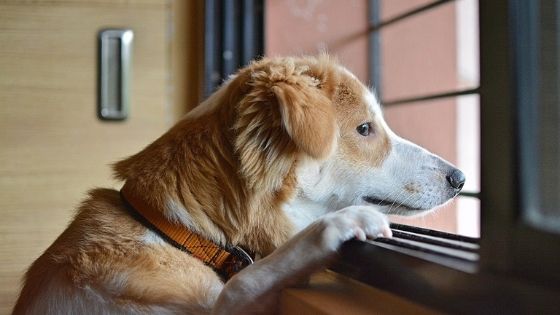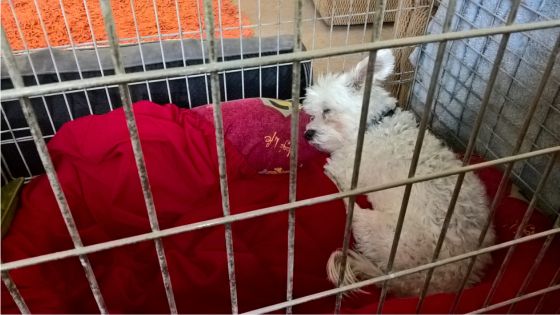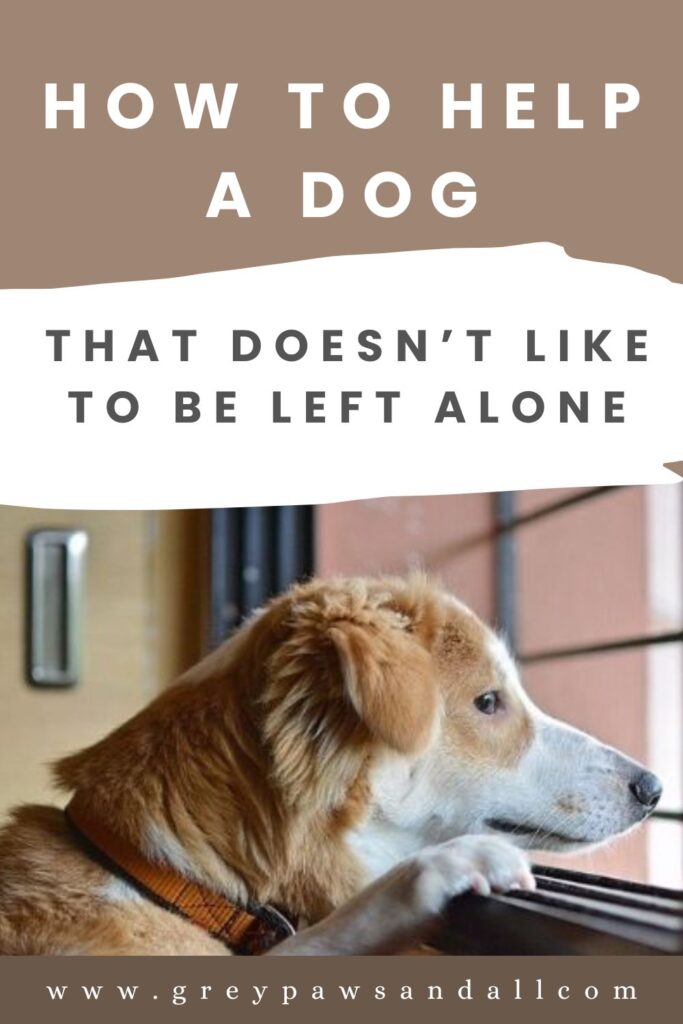What could be more heart breaking than watching a dog cry and panic when left alone? Running from room to room, frantically looking for his people and not finding them. There are varying degrees of this behavior known as separation anxiety, ranging from mild discomfort to literally ripping the house apart.
If your dog suffers from separation anxiety, provide plenty of physical exercise, mental stimulation, mix up the routine you follow before leaving the house, and never make a big deal when you leave or return.
*There are affiliate links in this post, which means if you make a purchase I may receive a small commission. This has no effect on the price you pay, and allows me to continue to provide helpful content.*
Is Dog Separation Anxiety a Phase?
It is not something a dog can outgrow, but it is possible in many cases, to reduce the severity. In fact, separation anxiety can develop, and in dogs that already have it, can worsen as they get older.
Are Certain Dog Breeds Prone to Separation Anxiety?
I’ve seen lists from different articles claiming that Labs, Retrievers, Chihuahas, Shepherds, Collies and Spaniels are more likely to develop it, but separation anxiety is certainly not limited to a specific breed. In fact, I’ve met a few Dachshund parents who are dealing with severe separation anxiety in their dogs, and they told me it’s very common in that breed. The bottom line is, a dog needs to be taught how to spend time alone, and unfortunately that doesn’t always happen.
Why Dogs Develop Separation Anxiety
Conclusive evidence as to why some dogs develop it really doesn’t exist, but there are some suspected causes:
- Moving house
- Puppies removed from litter too early
- A puppy never learning to be alone
- Being bounced around from shelter to shelter or home to home
- Neglect
- Loss of important people in his life
- An emotionally traumatic experience
- Lost in unfamiliar surroundings
- Change in schedule
- Canine Cognitive Dysfunction or doggie dementia

Dog Separation Anxiety Symptoms
You have a feeling something is going on, but aren’t sure what exactly. You may have come home to find your dog peed on the floor, shredded a pillow, or pulled down the drapes. Perhaps your neighbors told you they hear a lot of barking, crying or whining throughout the day.
The only way to see what’s going on, is to set up a nanny cam.
Depending on the severity of a dog’s anxiety, you may see/hear signs such as:
- Incessant barking
- Pacing
- Running from room to room searching for their people
- Being destructive
- Chewing through barriers confining them
- Drooling
- Panting
- Having accidents
When the person returns the greeting is frantic, as though they’ve been apart for a very long time. It goes without saying this is very stressful for the dog, the pet parent(s), and the neighbors forced to listen to this all day long.
Are You Sure Your Dog Has Separation Anxiety?
• Sometimes what seems like dog separation anxiety is actually boredom, since they both often result in destructive behavior, and excessive barking. Is it possible your dog is not getting much exercise or opportunities for mental stimulation?
• Have you recently adopted a dog, then gone straight back to work without an adjustment period? Getting used to a new environment for a dog of any age can cause anxiety.
• Is it possible your dog isn’t as well housetrained as he should be? That could explain the accidents in the house.
• Do you have an old dog that has started barking for seemingly no reason? Having accidents in the house? Crying if they aren’t with you all the time? It could be the beginning of dementia. Vision or hearing impairment also contributes to the development of a generalised anxiety, particularly if left alone.
• Previously housebroken dogs may “forget” their training due to dementia, or from being in a shelter environment for a long period of time.
• A medical issue such as diabetes, kidney disease or Cushing’s can cause frequent urination as can certain medications, which can lead to accidents in the house.
• Some pet parents resort to using a crate to confine their dog when they’re out, not realizing crate training is a process, not something you just throw your dog into. The “being locked up” part can cause serious anxiety, not the separation from you.
What are your thoughts? Does it seem like separation is causing the anxiety, or it’s more likely one of the scenarios listed above?
If you aren’t sure and it’s been a while since your dog has been to the vet, a visit is a good place to start. If a medical condition is the reason, diagnosis and treatment may resolve this issue.
Curing Dog Separation Anxiety Quickly
For the sake of this article, let’s assume you’ve investigated the above possible causes, and you’re sure it’s separation anxiety. In many cases it’s possible to significantly reduce the level of anxiety, but I wouldn’t use the word “cure.” It would be more realistic to say “manage.” As far as seeing results quickly, that will depend on how severe your dog’s anxiety is, and how consistent you are in the training.
I urge you to be patient, and accept it may take quite a long time to see a difference. That won’t necessary be the case, but the steps needed to help your dog are best done very slowly to increase the likelihood of success.

7 Ways to Help a Dog With Separation Anxiety
Physical Exercise
Every dog needs more than a backyard, but I can’t tell you how much exercise yours needs. The length, intensity, and frequency will depend on your dog’s age and physical condition, so I’d say it’s trial and error. At the very least start off with a few minutes walk in the morning, afternoon and evening and see how it goes. Tiring him out before you leave the house may make him more relaxed about spending time alone.
Enrol in a class
Training and fun classes are a great way for you and your dog to learn new skills you can practice together at home. It also helps with providing your dog with different types of physical activity and mental stimulation, both of which can help with stress relief.
Put what you’ve learned into practice before you leave the house.
Mental Stimulation
Training, games, tracking, and agility are just some of the ways to challenge your dog mentally, in addition to physically. Again, the activity you choose will depend on your dog’s physical capabilities, but perhaps some of the more challenging ones could be scaled back to accommodate if needed.
Mix up your routine to throw him off track
Most of us have a routine we follow each time we’re ready to leave the house. It doesn’t take long for your dog to learn it and realise once you’re finished, he’s going to be left alone. That can send him into full panic mode.
His anxiety may even start building as you begin getting ready, because he knows what’s coming. Changing your routine can help.
For example, he knows when you put your coat on, you leave the house. Why not put your coat on randomly during the day, then open the mail? Grab your keys, and put them in a different place.
After a few weeks with no discernible pattern, he may be less anxious when you walk out the door.
Never make a big deal out of leaving or returning
You know the tilt of the head a dog gives you when you go out? That look that says “I’m way too cute to leave me!” How many times do you go back in when you see the head tilt?
We smother them with affection and attention before we leave, and again when we return. Whether it’s guilt, or because we genuinely hate to be apart from them, it’s bad all around. All this drama simply adds to his anxiety. The better way is to not pay attention to your dog a few minutes before you leave, and for a few minutes after you get back.
The new message, and the right message you’re now sending him is, your absence is temporary and nothing to be concerned about.
Leave him something to enjoy
A Kong stuffed with a favourite treat can keep him busy, and if frozen lasts longer. A puzzle toy also provides a welcome distraction when you’re out. Keep these to use only when you’re out so they stay special. There are a few ideas listed below.
NOTE: A dog with a severe case of separation anxiety typically won’t eat when left alone.
Practice longer and longer absences
This exercise involves a gradual build-up of time spent out of the house. For this to work you need time, patience, and commitment.
Throughout this training, you must never allow your dog to reach that highly anxious state. Plan to spend about 20 minutes a session, which is comprised of the seconds here and there that you are actually out of the house, and a bit of time in between for breaks.
To begin – step out the front door for one minute, then come right back in. Remember, don’t make a big deal out of it.
If your dog suffers from severe anxiety, you may only be able to step outside for one second, literally, before coming back in. If that’s the case, then a second it will have to be.
Once you’re back in the house go about your business, giving your dog a few minutes to relax, then do it again, slightly increasing the time outside.
That might mean only 2 seconds, then 3 the next. That’s fine, just keep adding each time. You can also vary the length of time you stay out. For instance – say you’ve worked up to 7 minutes, the next time leave for 4 minutes, then 8, then 5.
Within a few weeks, your dog’s anxiety should be significantly reduced.
Important note: if at any time your dog barks or seems agitated when you’re out, you have moved too quickly. Go back to the time he was still comfortable, and start from that point. Also, if he does bark, try and wait for a split second of quiet before you go in.

What If You Can’t Even Leave the Room?
Your dog’s anxiety may be so severe you can’t even leave the room for a second, never mind the house. Don’t worry, start with this exercise.
A quick note: Start this training after he’s already been for a walk, and gotten rid of some energy. Giving him a bone or toy to keep his attention focused can also help.
• Sit in the same room, then without looking at your dog or saying anything, get up and move out of his line of sight. That could mean a different part of the room, or leaving it altogether, then immediately go back and sit down. Again, not looking or saying anything. Practice that a few times.
• It’s super important you come right back, so you he doesn’t get anxious. If he does start to whimper or bark, you were out too long.
• Repeat this a few times a day.
• If he did well, increase to 2 seconds, then 3 etc… As you continue you may find you can increase in 30 second increments, but play it by ear.
I know it sounds painstaking, but it gives you the best chance of helping.
Resolving Separation Anxiety at Night
It seems odd to think of a dog having separation anxiety at night. After all, separation anxiety happens when a dog is left alone, and night time is when everyone is home isn’t it? That is typically the case, but there are people who work nights and if they’re the only ones in the house, the dog will experience anxiety then.
There are other scenarios that could explain this as well.
• People with new puppies tend to spend all their time together, particularly during covid times, and new puppies often cry when left alone. If puppy parents don’t get them used to alone time, then at night when they aren’t together that’s when they’ll experience that anxiety.
• Your new puppy may have been sleeping in your room while getting used to his crate, so you can quickly take him out for a pee in the middle of the night. Since you’ve moved him to his own space to sleep, he’s become anxious.
• An old dog with sundowner’s for example (dementia), may sleep a lot during the day then pace all night, growing increasingly anxious if separated from their human.
• An old dog with vision/hearing issues who has become clingier, may panic when they’re not physically with their people.
What behaviors will a dog with this issue exhibit?
- Whining/crying/howling
- Panting
- Pawing and scratching at your bedroom door
- Pacing throughout the house
- Peeing/pooping in the house
How to treat night time separation anxiety
That will depend on the age of the dog.
♦ If your dog is in his crate in another part of the house, you may need to bring it into your bedroom for a while. Over the course of days or weeks, gradually move him further away from your bedside.
Every night, move the crate a little closer to the door. Your goal is to eventually move it to where you would like your dog to permanently sleep.
Depending on his anxiety level and how he reacts, you may be able to move it several inches at a time, or just one. When it comes to training, it’s always best to break things down into tiny steps and progress slowly. You end up with greater success that way.
If you don’t plan on having him always sleep in his crate, it’s up to you decide if you’re happy for him to have his own bed on the floor next to you or not.
♦ If your pup is whining but he’s in your bedroom, have you satisfied his needs before bed – exercise – had a drink – peed and perhaps pooped? If not, that could be the reason.
♦ If your dog is older, especially if this is a recent behavior, a trip to the vet should be a priority. A thorough exam along with urine and blood tests will help your vet with a diagnosis. If everything comes back normal, it’s likely he has dementia, but don’t panic because there are many treatment options that can help. For helpful information about dementia, see the article above.
♦ We mentioned earlier about never making a big deal when leaving and returning, the same can be said about your night time routine. Don’t make a whole fuss when it’s time for bed, just go.
♦ When it’s not anywhere near bed time, leave your dog in another room and you go to your bedroom. Stay there for just a moment, then go back and carry on with what you were doing. Each time increase the length of time you’re gone.
♦ Don’t let your pup sleep most of his day away. Engage with him, set up training sessions, play time and exercise. When it’s bed time you want him to be too tired to be anxious.
♦ Further down in this post you’ll find medication and supplement options to consider for anxiety, no matter what time of day.
Separation Anxiety in Older Dogs
Separation anxiety can be experienced by dogs of all ages, yet it is one of the most common behaviors in senior dogs. Not only can it be harder for older dogs to handle changes in routine, but losing hearing or sight will likely make them more anxious in general. Add dementia and an absent owner to the mix, and it’s a tough situation for everyone involved.
I am not in favour of using a crate for an old dog with these kinds of issues, because if they have to wander and are trapped they can really freak out. Imagine them trying to get out of that crate and hurting themselves in the process.
The best way to deal with this is have your dog checked by the vet. Getting a medical condition under control is the first step. You may also need to find someone to dog sit while you’re out, especially if you’ll be gone several hours.
Should You Crate Train a Dog with Separation Anxiety?

There are varying opinions on whether or not this is a good idea, I don’t think it is. If a dog is already anxious, putting him in a crate could freak him out. Imagine trying to claw his way out, and how hurt he could get in the process. A better solution could be to limit access by using baby gates. This allows him to wander, but in a smaller space.
I believe crates are wonderful tools, and certainly when my dog was recovering from spinal surgery it was a lifesaver, but they aren’t appropriate in every situation.
In order to provide your anxious dog with a safe space to relax, a crate with a cover, door kept open, a comfy bed and some calming spray may be just what he needs.
Dog Separation Anxiety Medication
The training tips above can help reduce anxiety, but combining that with medication and natural options can have a greater effect. It is often a case of trial and error, and be sure to consult your vet before trying any supplements.
A chat with your vet
Speak to your vet about prescribing a low dose anti-anxiety tablet for short term use. You may prefer a natural route, but in this case instant relief may be the kindest thing you can do. Less stress might also mean greater ability to focus on the training.
For dogs with dementia
- Solliquin
- Purina Bright Mind food
- Anipryl/Selgian
- Aktivait
- Nutramind (UK)
- Nutracalm (UK)
Here are some helpful articles for anyone reading this who has a dog with dementia, or knows someone who does.
A Comprehensive Guide to Dog Dementia
Does Your Senior Dog Have Dementia
Get your dog some company
Rather than leaving your dog alone, why not hire a dog walker or ask a neighbour, family member or friend to help? If you don’t have the budget, perhaps an exchange of service will work.
Doggie Day care
A doggie day care facility is such a great option. Your dog will have others to run around and play with, which will provide him with much needed exercise and a chance to socialise.
Reminders of you
Some dogs are comforted by having a t-shirt or sweater with their owner’s scent on it, in their bed. Give him one you’ve worn recently.
Teach your dog independence
Help your dog learn independence by paying him attention when you want, not when he wants. He will soon learn he gets more attention by not constantly seeking it out.
For a list of natural treatment options, please refer to the article below. All recommendations have been used by owners of anxious dogs, and were found to be helpful.
Please read this ⇒ 22 Natural Ways to Calm Your Anxious Dog
Dog Separation Anxiety Toys
Any toy your dog likes is a distraction, but the four listed below are particularly good for anxiety. In a survey I conducted with members of my FB group, Senior Dog Care Club, they were voted the most popular by 648 people who share their lives with anxious dogs.

Is Separation Anxiety Preventable?
There are lots of things to minimize the chances, but it’s not always preventable. Even if your dog has no anxiety throughout most of his life, it’s still possible he will experience it in later years.
Prevention
• Help your dog learn independence by paying him attention when you want, not when he wants. He will soon learn he gets more attention by not constantly seeking it out.
• Provide a routine and structure, making sure to include plenty of physical exercise and mental stimulation. A dog with no way to release energy will become an anxious dog.
• Socializing your dog means getting him comfortable living in our world. Introduce him to various people, animals, household items, cars, bikes, loud noises, floor surfaces etc…This will make him a more relaxed dog, less prone to anxiety
• Crate training will teach him how to be okay alone, and give him a safe area of his own.
• Practice the steps in the section “What if you can’t even leave the room.”
NOTE: If separation anxiety is caused by dementia, vision or hearing issues, medication, supplements and having company in the house may be the only way to help.
What steps have you taken to reduce your dog’s separation anxiety? Sharing helps others, so please share in the comments below.
If you’re looking for a community of senior dog parents, a place where you can find helpful tips, support and people who “get it” please join my FB group Senior Dog Care Club
If you’re struggling, my Senior Dog Care Support Service is for you.
I offer 1:1 support on everything from health & wellness advice and training tips, to preparing to say goodbye and grief counselling. You can find details as well as a link to book a FREE 20 minute discovery call here. If you have any questions please email Hindy at hpearson141@gmail.com
I’ve been rescuing and caring for senior dogs since 2009. From vision and hearing loss to obesity, dementia, kidney disease, liver issues, cardiac problems, Cushing’s, mobility challenges and more, you could say I’ve dealt with and learned a lot! In addition to my hands on experience, I’ve taken many courses and earned several qualifications to keep learning how to help senior dogs and they include: Senior Dog Enrichment, Understanding Canine Anxiety, Care of the Senior Pet and I’m a Certified Pet Loss Specialist.
